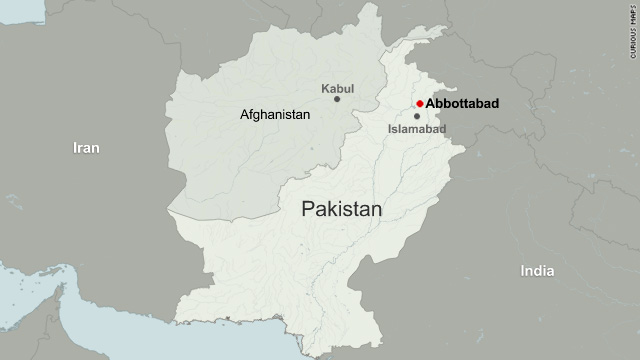 Osama bin Laden's death Monday marked the end of an era for U.S. investigators, who searched remote villages and mountain caves in a far-reaching manhunt for the al Qaeda leader.
Osama bin Laden's death Monday marked the end of an era for U.S. investigators, who searched remote villages and mountain caves in a far-reaching manhunt for the al Qaeda leader.Their search, which lasted more than a decade, ended early Monday local time, when a small U.S. team raided a heavily guarded hideout and killed him.
The key break in the case came in August, when senior Obama administration officials say U.S. intelligence honed in on a $1 million compound in an affluent area north of Islamabad where one of bin Laden's couriers lived.
But the trail that eventually led the United States to bin Laden began years ago, the officials said.
After years of thwarted searches and dead ends, finding the elusive bin Laden had become "America's most vexing intelligence problem," one senior Obama administration official told reporters in a background briefing in Washington early Monday.





RELATED TOPICS
But a new lead emerged when post-9/11 detainees gave investigators a glimpse into the al Qaeda chief's inner circle, the official said. During questioning, detainees repeatedly mentioned the nickname of a man they said was one of the few couriers bin Laden trusted.
U.S. intelligence uncovered the courier's identity four years ago. It took two more years to identify where the courier and his brother operated in Pakistan.
But "extensive operational security" kept investigators from pinpointing where they lived, the senior administration official said.
"The fact that they were being so careful reinforced our belief that we were on the right track," the official said.
In August 2010, the official said, U.S. intelligence honed in on the home where the two brothers lived with their families, located in Abbottabad, Pakistan -- about 35 miles north of Islamabad.
"When we saw the compound where the brothers lived, we were shocked by what we saw -- an extraordinarily unique compound," the senior administration official said. "The compound sits on a large plot of land in an area that was relatively secluded when it was built. It is roughly eight times larger than the other homes in the area."
The senior Obama administration official said several things about the compound immediately stood out: residents burned their trash rather than leaving it out for collection, there was no telephone or internet service and the three-story main structure had few windows facing outside. In addition, 12- to 18-foot walls topped with barbed wire surrounded the compound.
Intelligence analysts concluded the compound was "custom-built to hide someone of significance," the official said, and they noted that the courier and his brother had no discernible source of wealth to live at such a property.
"Everything we saw ... was perfectly consistent with what our experts expected bin Laden's hideout to look like," the official said.
Intelligence soon revealed that a third family lived at the compound, the senior administration official said, "one whose size and whose makeup matched the bin Laden family members that we believed most likely to be with Osama bin Laden."
Even after analysts used multiple methods to analyze "every angle" of the information, "no other candidate fit the bill as well as bin Laden did," the official said.
U.S. officials did not release the courier's identity or specify how they found the home. A senior Pakistani intelligence official mentioned electronic and phone tracking, and said the U.S. intelligence on bin Laden's whereabouts was primarily based on Pakistani information passed along to the Americans.
Senior administration officials said the CIA informed Obama in September that assessments indicated bin Laden could be in a compound in Pakistan. By mid-February, the intelligence was considered strong enough to begin considering action pledged by Obama when bin Laden's whereabouts had been determined.
To discuss that intelligence and develop a plan, Obama chaired five National Security Council meetings from mid-March until late April, with the last two on April 19 and April 28 -- last Thursday.
The next day, Obama gave the order for the mission, officials said.
He decided to pursue a targeted approach because officials were not certain they would find bin Laden inside the compound, one senior administration official said.
"We had a 50-50 shot that he was there. There was no guarantee by any stretch," the official said.
At 8:20 a.m. ET Friday, before leaving on a trip to tour tornado devastation in Alabama, Obama made the decision to undertake the operation, a senior administration official said.
Late Sunday night in a White House address to the American people, Obama described the daring raid by a small U.S. team that killed bin Laden.
One U.S. government official told CNN the operation that killed the founder and leader of al Qaeda was designed to do just that, not to take him alive. But another senior U.S. official told CNN the operation included instructions to arrest bin Laden alive if he had surrendered -- however, no one involved expected that he would surrender.
Authorities have not determined how long the three-story home has been bin Laden's hideaway.
"The compound had been in existence for roughly five years, but we don't know how long bin Laden lived there," a senior administration official said at the Monday.
But they were unequivocal in their declarations of his death.
On the web page containing the FBI's most-wanted list, a clear message was spelled out in bold letters beneath bin Laden's picture: "Deceased."
In an e-mail to CIA staff Monday, Director Leon Panetta praised the "highly complex, innovative, and forward-leaning clandestine operations" that he said led them to bin Laden.
"We have rid the world of the most infamous terrorist of our time," he wrote.
No comments:
Post a Comment